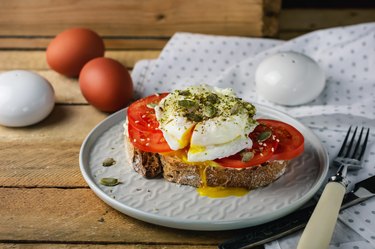 How to Poach an Egg Without a Poacher Image Credit: Nataliia Sirobaba/iStock/GettyImages
How to Poach an Egg Without a Poacher Image Credit: Nataliia Sirobaba/iStock/GettyImages
Poaching eggs takes practice, but the process isn't nearly as fussy as some recipes make it seem. A well-poached egg has a tender white and a runny yolk, and there's no harm or shame in trimming off any ragged edges of yolk. Eggs Benedict isn't the only dish for poached eggs — put one on a burger or atop a bowl of ramen.
Video of the Day
How to Poach Eggs
- Bring a pot filled with about 6inches of water to a gentle simmer. The water should be warm, with anoccasional bubble rising to the top, but not boiling.
- While you're waiting for the water tocome to temperature, gather your equipment. You'll need a small bowl or ramekin,paper towels and a slotted spoon.
- Crack an egg into the bowl, beingcareful not to break the yolk. If you do break the yolk, set that egg aside foruse in another recipe.
- Once the water is simmering, carefullyslide the egg into the water.
- The egg is poached when the white isset and the yolk is still runny. This should take three to four minutes. Use aslotted spoon to scoop the egg out of the water, taking care not to break theyolk.
- Set it on a paper towel to drain.
Poached Eggs Tips and Tricks
The fresher the egg, the more likely it is to hold its shape when you slide it into the water. Add a teaspoon of vinegar to the water before you add the egg. This will prevent the egg white from spreading when you put it in the water.
The egg white should be cooked through but still tender rather than rubbery. If the egg white is cooked but the yolk is runnier than you prefer, spoon water from the pot over the yolk until it's slightly set but still runny.
If you're making poached eggs to use later, chill them quickly in cold water after they're cooked. To reheat, return them to simmering water for 30 seconds before serving. If you find yourself having trouble with the egg white spreading out in the pan, try swirling the water before you add the egg. The swirling water should keep the egg white intact.
Poached Egg Dishes
Eggs Benedict, a brunch dish first served in the 1800s, consists of an English muffin with a slice of ham or Canadian bacon topped with a poached egg and drizzled with hollandaise sauce.
Adding turmeric to the poaching liquid results in bright yellow egg whites for a burst of color on avocado toast. Eggs poached in butter are a decadent delight. The technique is the same, but the eggs cook in clarified butter. To clarify butter, melt it in a heavy saucepan until it turns clear. The solids will settle on the bottom of the pan. Pour off the clear liquid without disturbing the solids.
A poached egg on top of a hamburger or as a topping for a bowl of ramen adds richness. Add a poached egg to your morning bowl of oatmeal or granola for a protein punch. Eggs are poached in a highly seasoned combination of tomatoes, onions and peppers for shakshuka, a Middle Eastern breakfast dish.
Using Egg Poachers
Unless the egg is cooked with direct contact with warm liquid, it's technically not a poached egg, but there have been dozens of devices on the market for years for soft-cooking eggs. Some are electric, some work in the microwave and there is even a version for the Instant Pot.
Microwave poachers typically have a cup or two for the eggs and a tight-fitting lid. The eggs cook in a few minutes, and there's much less to clean up.
Egg poachers for the stove top are usually silicone cups that float on top of simmering water in a pot. You can also cook scrambled eggs in them or cook the eggs all the way through for recipes that call for hard-boiled eggs. If you find yourself making multiple poached eggs for brunches or crowds, consider a stove-top poacher that holds six eggs.


































